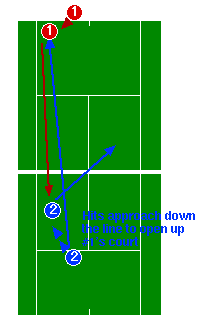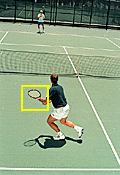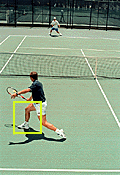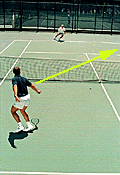<% ns_puts [nsv_get mkm_includes mkm_oldContentHeader_inc] %>
Strategy Lesson
of the Week
Finishing the Point with the Angled Volley
By Brian Garrow
Written by Jim McLennan, TennisONE Senior Editor
In tennis, there are two opponents: yourself and the other guy. This principle
is a reminder that before you can ever attempt to beat your opponent, you
must first learn not to beat yourself. This generally means you must be
consistent, keep the ball in play, and hit one more shot than your opponent.
Now let's say you are in a match where your opponent is as consistent as
you are. One tactic for beating him-- since he's not beating himself-- is
to open the court and play the ball into the opening. On the professional
level, you can see Agassi and Sampras exchanging 5 and 10 backhand crosscourt
shots without forcing an error. Then one or other goes down the line. If
the down the line shot is good enough, it is either a winner or forces an
error. If it's not good enough, the player who has gone down the line exposes
his court to a winning crosscourt reply. In critical moments in last year's
US Open final, Sampras almost seemed to entice Agassi to go down the line
first. Then Sampras was ready to pounce and hit a running forehand winner
into Agassi's exposed forehand court. The idea here is not to imitate this
tactic, but to develop your own favorite plays for opening up the court
and hitting a decisive crosscourt winner.
 In this lesson, we're focusing on hitting
the angled volley for a winner, which is demonstrated by Brian Garrow, former
NCAA doubles champion and semi-finalist in the US Open doubles championship.
Brian has volleyed his initial backhand deep and down the line. This pulls
his opponent to one side of the court while allowing him to close to the
net and hit a winning angled volley into his opponent's exposed court.
In this lesson, we're focusing on hitting
the angled volley for a winner, which is demonstrated by Brian Garrow, former
NCAA doubles champion and semi-finalist in the US Open doubles championship.
Brian has volleyed his initial backhand deep and down the line. This pulls
his opponent to one side of the court while allowing him to close to the
net and hit a winning angled volley into his opponent's exposed court.
But there is more here than meets the eye. In order to play a sharply angled
crosscourt volley, the backswing must be extremely short and the hitting
action must be across the body. In the first photo below, note how high
Brian carries his racquet as he moves into second volley position. He
carries his hands high and uses both hands to carefully adjust the racquet
face in preparation for his angled volley. This is all in contrast
with many club players who come racing into the net with the racquet dangling
down in one hand (see Dan Leon's lesson on split-step). If that is the case,
players don't have the time or control to play a successful angled volley.
And when the ball is not properly angled, your opponent can easily reach
it and play into your open court.
In the second photo, Brian demonstrates a good cross-over step on the volley.
This provides him with the good shoulder turn and forward momentum
to generate a sharply hit volley without taking a backswing. Taking
a backswing will both make you late for the volley and rob you of the control
you need to execute this shot consistently.



Send in Your Strategy Questions to TennisONE
If you think you have a good TennisONE Strategy Question, please send an
email to: question@tennisone.com.
<% ns_puts [nsv_get mkm_includes mkm_oldContentFooter_inc] %>



 In this lesson, we're focusing on hitting
the angled volley for a winner, which is demonstrated by Brian Garrow, former
NCAA doubles champion and semi-finalist in the US Open doubles championship.
Brian has volleyed his initial backhand deep and down the line. This pulls
his opponent to one side of the court while allowing him to close to the
net and hit a winning angled volley into his opponent's exposed court.
In this lesson, we're focusing on hitting
the angled volley for a winner, which is demonstrated by Brian Garrow, former
NCAA doubles champion and semi-finalist in the US Open doubles championship.
Brian has volleyed his initial backhand deep and down the line. This pulls
his opponent to one side of the court while allowing him to close to the
net and hit a winning angled volley into his opponent's exposed court.

